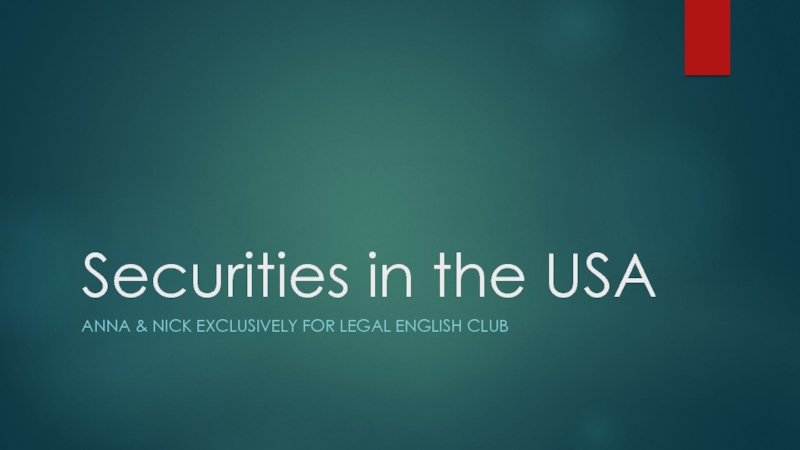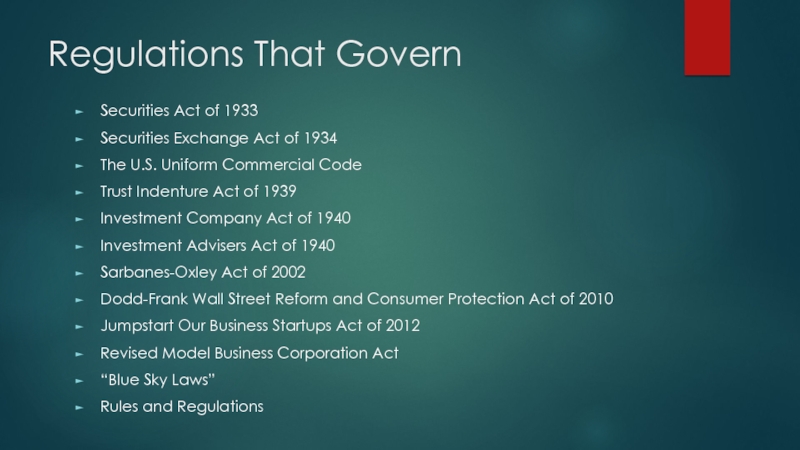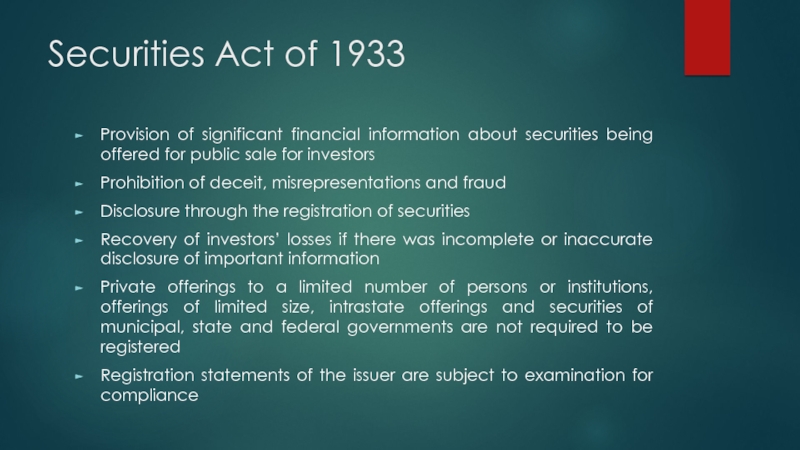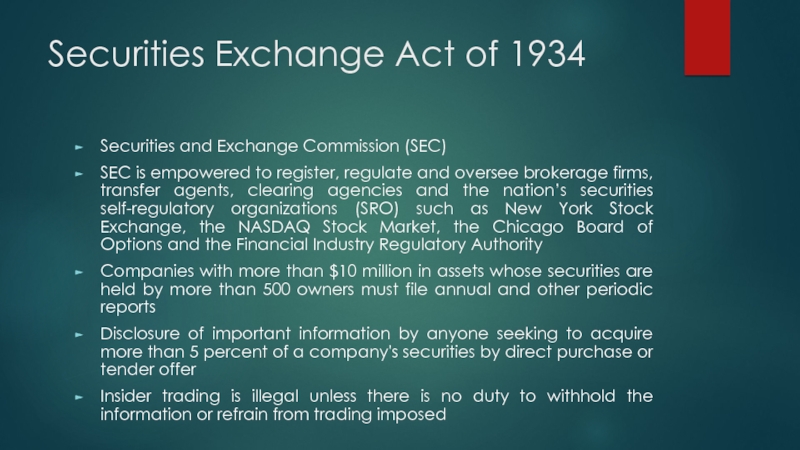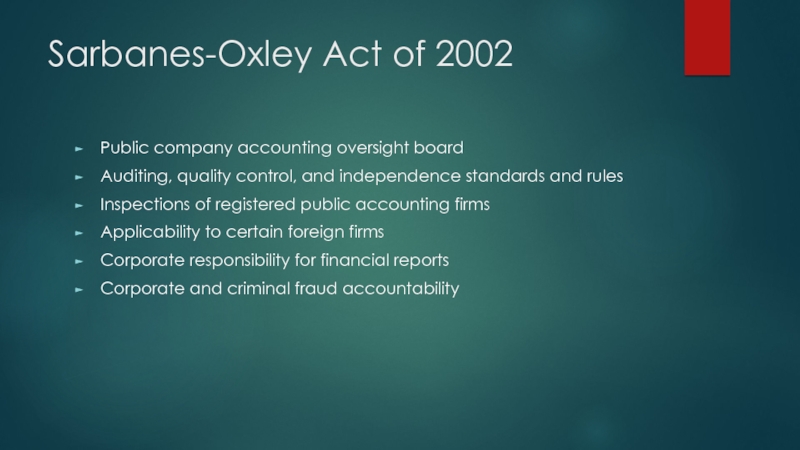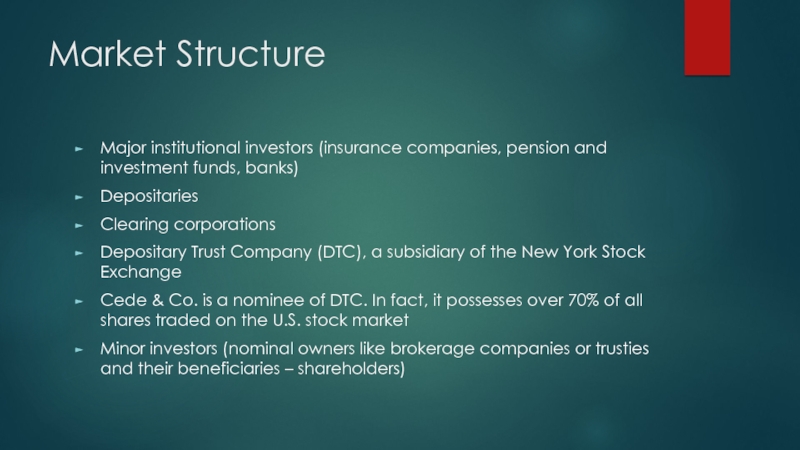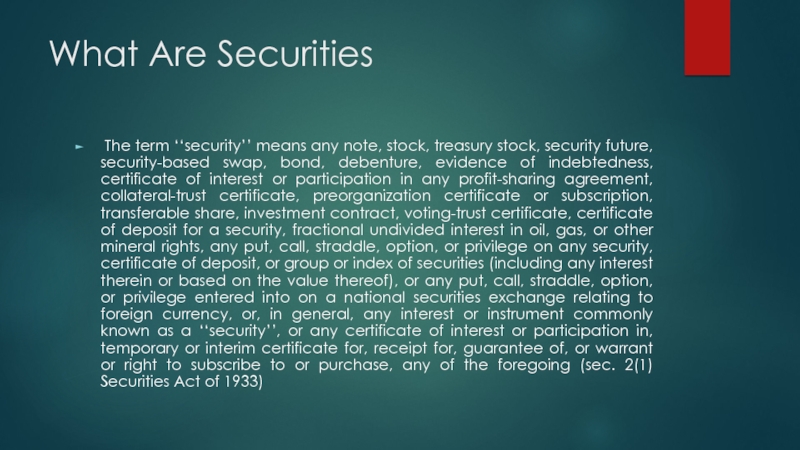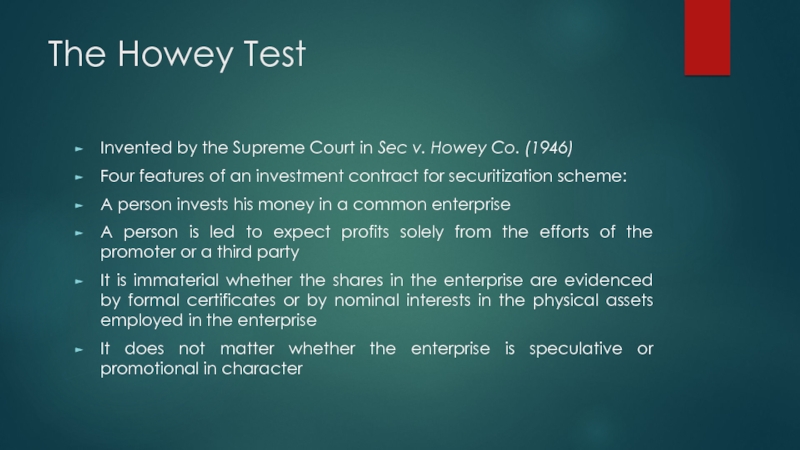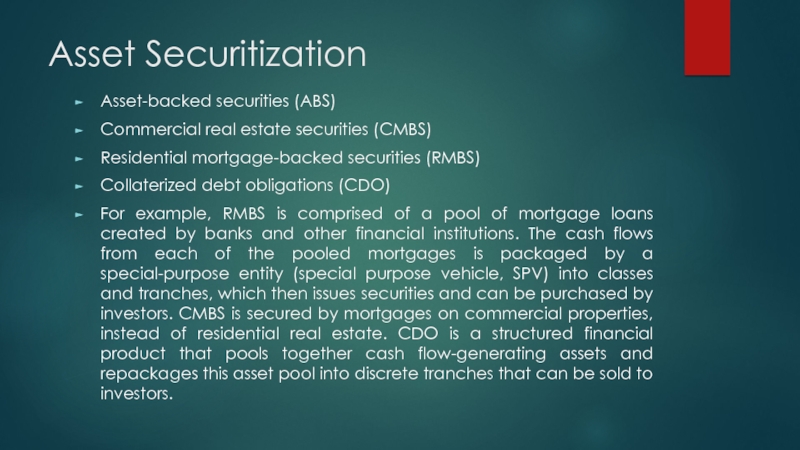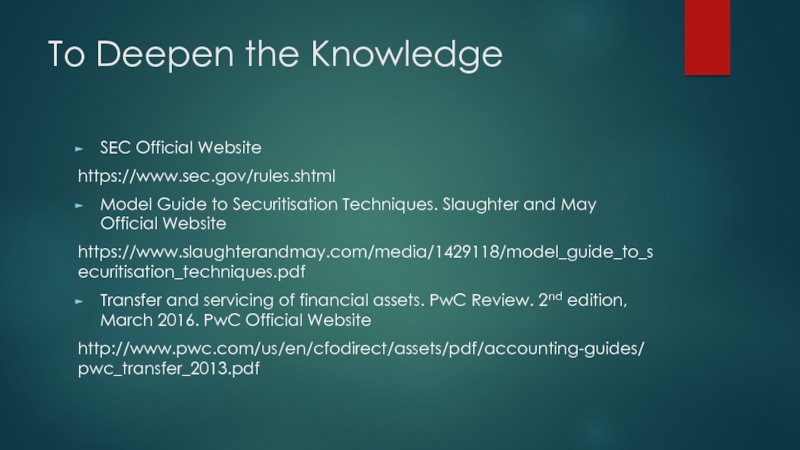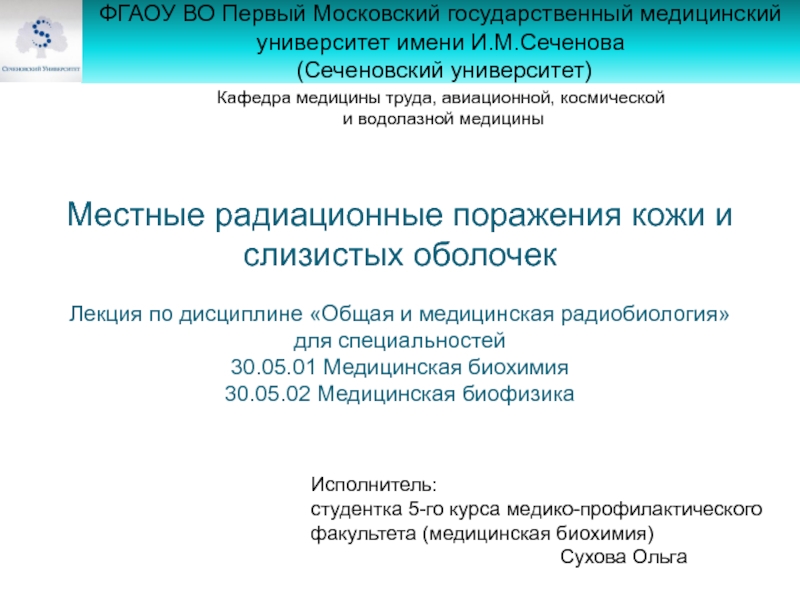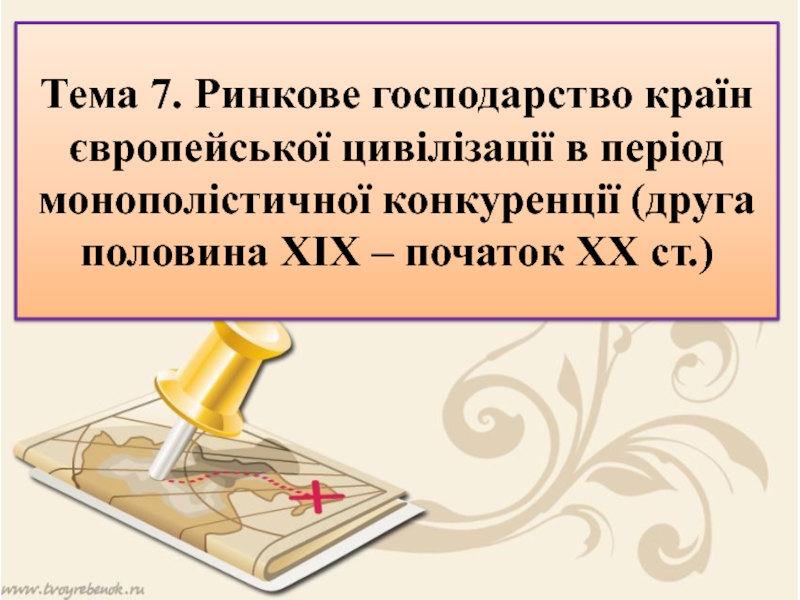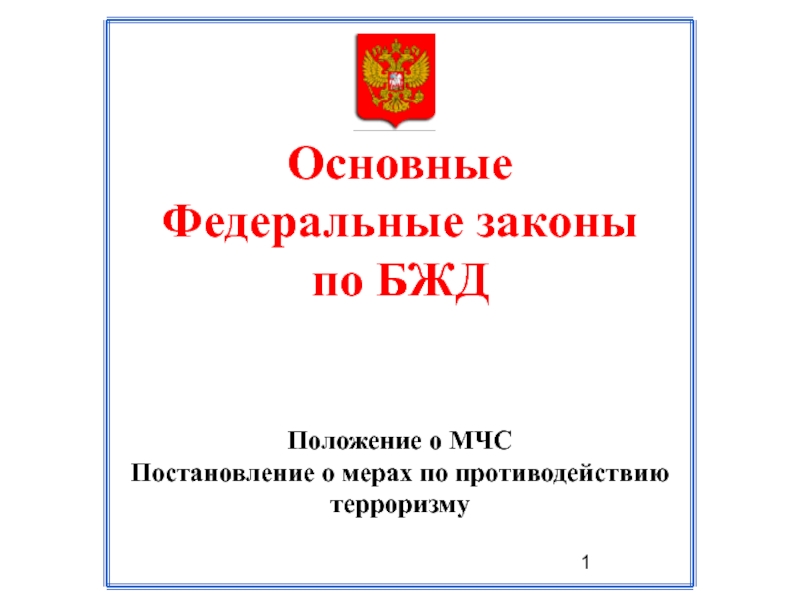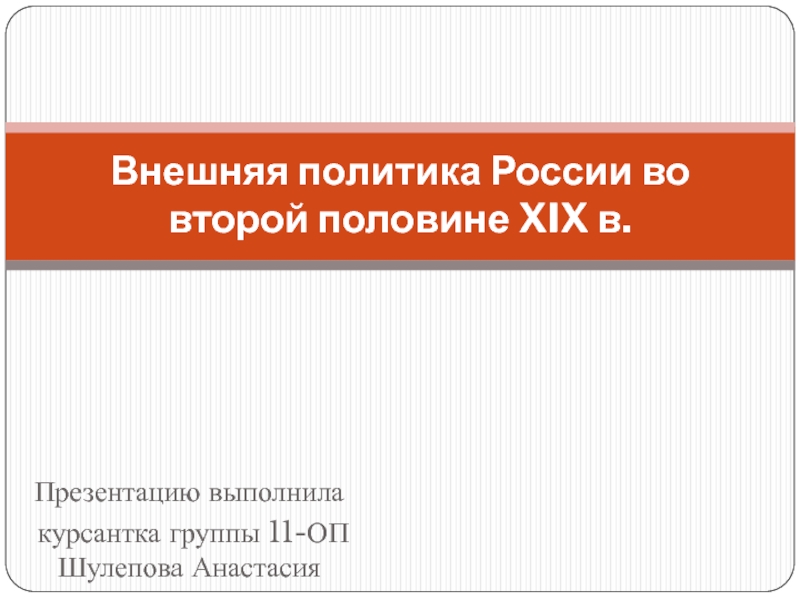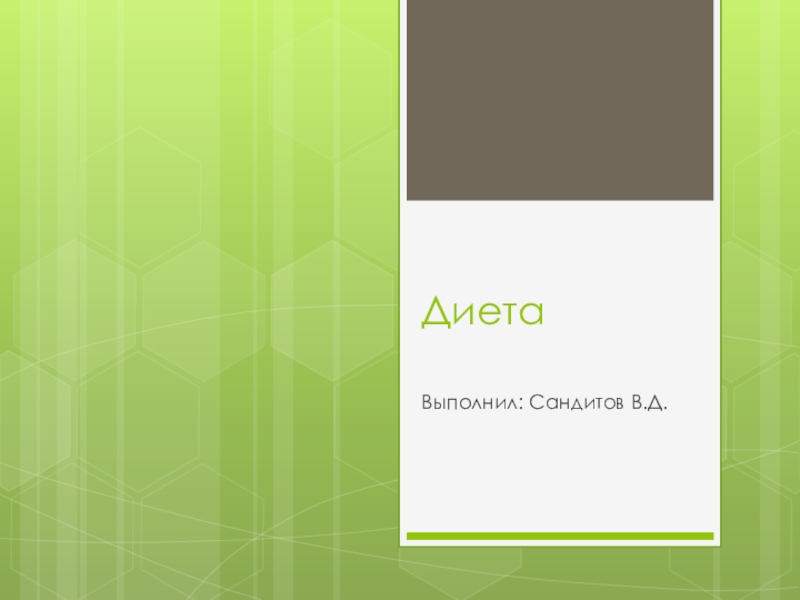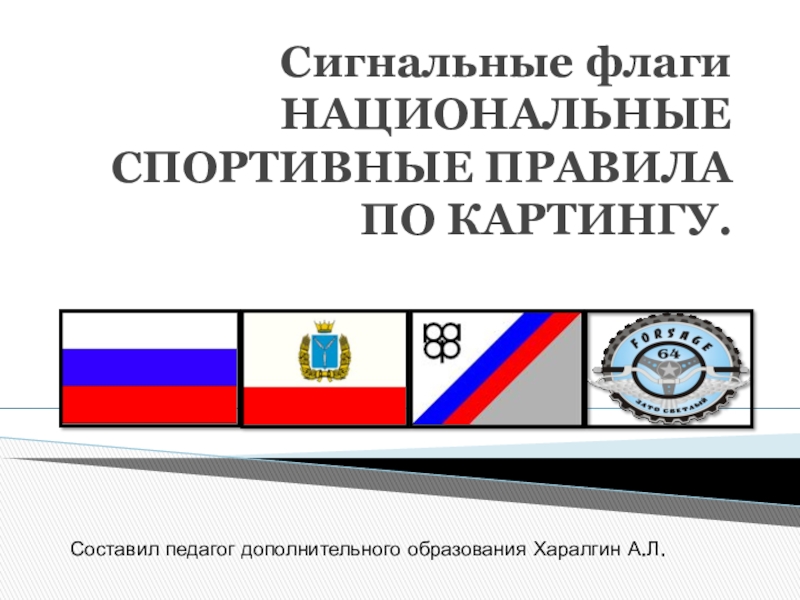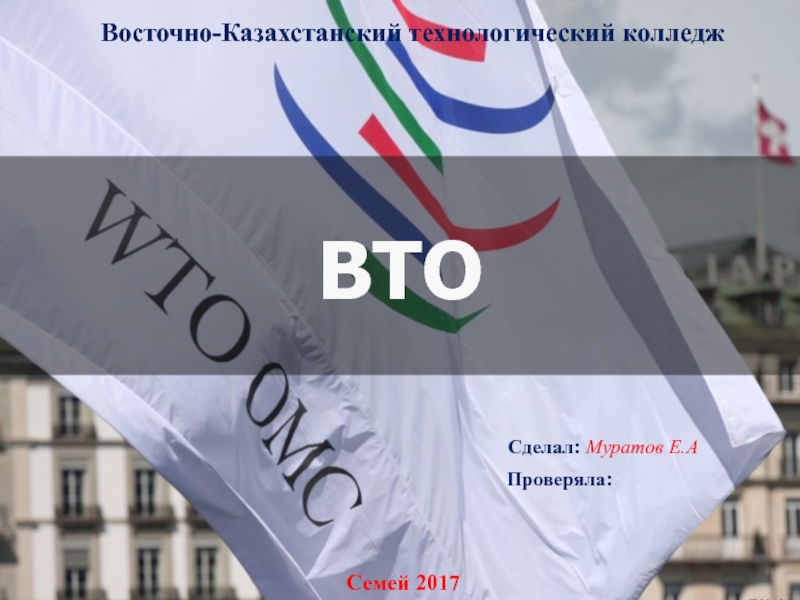Разделы презентаций
- Разное
- Английский язык
- Астрономия
- Алгебра
- Биология
- География
- Геометрия
- Детские презентации
- Информатика
- История
- Литература
- Математика
- Медицина
- Менеджмент
- Музыка
- МХК
- Немецкий язык
- ОБЖ
- Обществознание
- Окружающий мир
- Педагогика
- Русский язык
- Технология
- Физика
- Философия
- Химия
- Шаблоны, картинки для презентаций
- Экология
- Экономика
- Юриспруденция
Securities in the USA
Содержание
- 1. Securities in the USA
- 2. Regulations That GovernSecurities Act of 1933Securities Exchange
- 3. Securities Act of 1933 Provision of significant
- 4. Securities Exchange Act of 1934 Securities and
- 5. Sarbanes-Oxley Act of 2002 Public company accounting
- 6. Market StructureMajor institutional investors (insurance companies, pension
- 7. What Are Securities The term ‘‘security’’ means
- 8. The Howey TestInvented by the Supreme Court
- 9. Financial InstrumentsInvestment securities:equity securities (stocks)debt securitiesoptionsconvertible bondsshare certificateNegotiable instrumentsDocument of titleQuasi-negotiable
- 10. Asset SecuritizationAsset-backed securities (ABS)Commercial real estate securities
- 11. To Deepen the KnowledgeSEC Official Website https://www.sec.gov/rules.shtmlModel
- 12. Thank you for attention!
- 13. Скачать презентанцию
Regulations That GovernSecurities Act of 1933Securities Exchange Act of 1934The U.S. Uniform Commercial CodeTrust Indenture Act of 1939Investment Company Act of 1940Investment Advisers Act of 1940Sarbanes-Oxley Act of 2002Dodd-Frank Wall Street
Слайды и текст этой презентации
Слайд 2Regulations That Govern
Securities Act of 1933
Securities Exchange Act of 1934
The
U.S. Uniform Commercial Code
Trust Indenture Act of 1939
Investment Company Act
of 1940Investment Advisers Act of 1940
Sarbanes-Oxley Act of 2002
Dodd-Frank Wall Street Reform and Consumer Protection Act of 2010
Jumpstart Our Business Startups Act of 2012
Revised Model Business Corporation Act
“Blue Sky Laws”
Rules and Regulations
Слайд 3Securities Act of 1933
Provision of significant financial information about
securities being offered for public sale for investors
Prohibition of
deceit, misrepresentations and fraud Disclosure through the registration of securities
Recovery of investors’ losses if there was incomplete or inaccurate disclosure of important information
Private offerings to a limited number of persons or institutions, offerings of limited size, intrastate offerings and securities of municipal, state and federal governments are not required to be registered
Registration statements of the issuer are subject to examination for compliance
Слайд 4Securities Exchange Act of 1934
Securities and Exchange Commission (SEC)
SEC is empowered to register, regulate and oversee brokerage firms,
transfer agents, clearing agencies and the nation’s securities self-regulatory organizations (SRO) such as New York Stock Exchange, the NASDAQ Stock Market, the Chicago Board of Options and the Financial Industry Regulatory AuthorityCompanies with more than $10 million in assets whose securities are held by more than 500 owners must file annual and other periodic reports
Disclosure of important information by anyone seeking to acquire more than 5 percent of a company's securities by direct purchase or tender offer
Insider trading is illegal unless there is no duty to withhold the information or refrain from trading imposed
Слайд 5Sarbanes-Oxley Act of 2002
Public company accounting oversight board
Auditing, quality
control, and independence standards and rules
Inspections of registered public accounting
firmsApplicability to certain foreign firms
Corporate responsibility for financial reports
Corporate and criminal fraud accountability
Слайд 6Market Structure
Major institutional investors (insurance companies, pension and investment funds,
banks)
Depositaries
Clearing corporations
Depositary Trust Company (DTC), a subsidiary of the New
York Stock ExchangeCede & Co. is a nominee of DTC. In fact, it possesses over 70% of all shares traded on the U.S. stock market
Minor investors (nominal owners like brokerage companies or trusties and their beneficiaries – shareholders)
Слайд 7What Are Securities
The term ‘‘security’’ means any note, stock,
treasury stock, security future, security-based swap, bond, debenture, evidence of
indebtedness, certificate of interest or participation in any profit-sharing agreement, collateral-trust certificate, preorganization certificate or subscription, transferable share, investment contract, voting-trust certificate, certificate of deposit for a security, fractional undivided interest in oil, gas, or other mineral rights, any put, call, straddle, option, or privilege on any security, certificate of deposit, or group or index of securities (including any interest therein or based on the value thereof), or any put, call, straddle, option, or privilege entered into on a national securities exchange relating to foreign currency, or, in general, any interest or instrument commonly known as a ‘‘security’’, or any certificate of interest or participation in, temporary or interim certificate for, receipt for, guarantee of, or warrant or right to subscribe to or purchase, any of the foregoing (sec. 2(1) Securities Act of 1933)Слайд 8The Howey Test
Invented by the Supreme Court in Sec v.
Howey Co. (1946)
Four features of an investment contract for securitization
scheme:A person invests his money in a common enterprise
A person is led to expect profits solely from the efforts of the promoter or a third party
It is immaterial whether the shares in the enterprise are evidenced by formal certificates or by nominal interests in the physical assets employed in the enterprise
It does not matter whether the enterprise is speculative or promotional in character
Слайд 9Financial Instruments
Investment securities:
equity securities (stocks)
debt securities
options
convertible bonds
share certificate
Negotiable instruments
Document of
title
Quasi-negotiable
Слайд 10Asset Securitization
Asset-backed securities (ABS)
Commercial real estate securities (CMBS)
Residential mortgage-backed securities
(RMBS)
Collaterized debt obligations (CDO)
For example, RMBS is comprised of a
pool of mortgage loans created by banks and other financial institutions. The cash flows from each of the pooled mortgages is packaged by a special-purpose entity (special purpose vehicle, SPV) into classes and tranches, which then issues securities and can be purchased by investors. CMBS is secured by mortgages on commercial properties, instead of residential real estate. CDO is a structured financial product that pools together cash flow-generating assets and repackages this asset pool into discrete tranches that can be sold to investors. Слайд 11To Deepen the Knowledge
SEC Official Website
https://www.sec.gov/rules.shtml
Model Guide to Securitisation
Techniques. Slaughter and May Official Website
https://www.slaughterandmay.com/media/1429118/model_guide_to_securitisation_techniques.pdf
Transfer and servicing of financial
assets. PwC Review. 2nd edition, March 2016. PwC Official Websitehttp://www.pwc.com/us/en/cfodirect/assets/pdf/accounting-guides/pwc_transfer_2013.pdf
